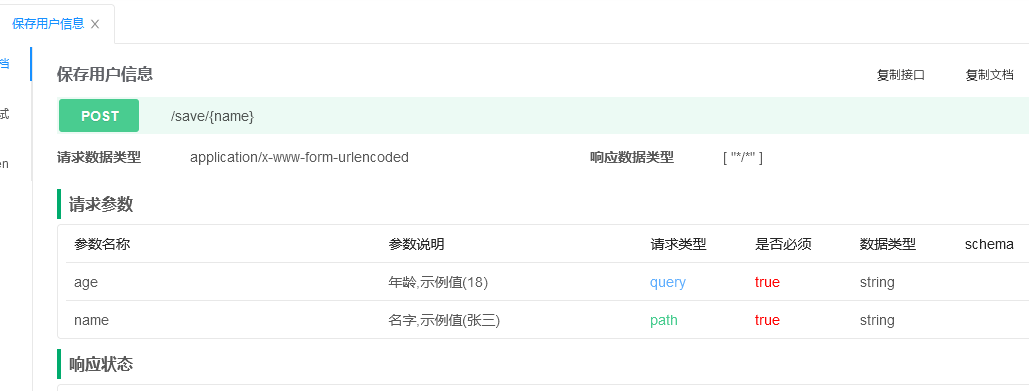安装
<dependencyManagement>
<dependencies>
<!-- Knife4J 接口文档增强 -->
<dependency>
<groupId>com.github.xiaoymin</groupId>
<artifactId>knife4j-spring-boot-starter</artifactId>
<version>2.0.9</version>
</dependency>
</dependencies>
</dependencyManagement>
<dependencies>
<!-- Knife4J 接口文档增强 -->
<dependency>
<groupId>com.github.xiaoymin</groupId>
<artifactId>knife4j-spring-boot-starter</artifactId>
</dependency>
</dependencies>
- 新建
Knife4jConfig.java文件
/**
* swagger config for open api.
*/
@Configuration
@EnableSwagger2WebMvc
public class Knife4jConfig implements WebMvcConfigurer {
/**
* 用于读取配置文件 application.properties 中 swagger 属性是否开启
*/
@Value("${knife4j.enabled}")
private Boolean swaggerEnabled;
@Bean
public Docket docket() {
return new Docket(DocumentationType.SWAGGER_2)
.apiInfo(apiInfo())
// 是否开启swagger
.enable(swaggerEnabled)
.select()
// 过滤条件,扫描指定路径下的文件
.apis(RequestHandlerSelectors.basePackage("com.eezd.main.web"))
// 指定路径处理,PathSelectors.any()代表不过滤任何路径
.paths(PathSelectors.any())
.build();
}
private ApiInfo apiInfo() {
return new ApiInfoBuilder()
.title("Knife4j 4.4.x & Spring Boot 2.7 & Swagger2")
.description("Knife4j 4.4.x & Spring Boot 2.7 & Swagger2")
.termsOfServiceUrl("https://134333.xyz/")
.contact(new Contact("接口文档", "https://134333.xyz", "eezd@outlook.com"))
.version("")
.build();
}
}
@Api
@Api: 对 类 进行描述
@RestController
@Slf4j
@Api(tags = "hello")
public class HelloController {}
@ApiOperation
@ApiOperation: 对 请求 进行描述
@RestController
@Slf4j
@Api(tags = "hello")
public class HelloController {
@GetMapping("/")
@ApiOperation(value = "hello", notes = "hello测试模块")
public String hello() {
return "Hello World";
}
}
对请求参数进行描述
有两种方式可以描述
- 第一种:
@ApiImplicitParams+@ApiImplicitParam- name: 参数名
- value: 参数说明描述
- dataType: 类型, 默认
string__file: 文件类型stringintarray- 如果需要表示数组, 请查看最下面的
allowMultiple数组参数
- required: 是否是必传
- paramType: 参数获取方式
- header »>
@RequestHeader - query »>
@RequestParam - path »>
@PathVariable - body »>
- form »>
- header »>
- example: 实例值, 点调试那里就看得到了
@ApiOperation("保存用户信息")
@ApiImplicitParams({
@ApiImplicitParam(name = "name", value = "名字", dataType = "string", required = true, paramType = "path", example = "张三"),
@ApiImplicitParam(name = "age", value = "年龄", dataType = "int", required = true, paramType = "query", example = "18")
})
@PostMapping("/save/{name}")
@ResponseBody
public String save(
@PathVariable("name") String name,
@RequestParam("age") Integer age
) {
return name + " " + age;
}

- 第二种
@ApiParam: 对代码侵入比较大
@ApiOperation("保存用户信息")
@PostMapping("/save/{name}")
@ResponseBody
public String save(
@ApiParam(value = "名字", required = true, example = "张三")
@PathVariable("name") String name,
@ApiParam(value = "年龄", required = true, example = "18")
@RequestParam("age") Integer age
) {
return name + " " + age;
}
@ApiModel
- 给模型绑定描述的
@ApiModel(value = "用户登录对象")
@Data
public class LoginBody implements Serializable {
/**
* 用户名
*/
@ApiModelProperty(value = "用户名", example = "Admin")
private String username;
/**
* 用户密码
*/
@ApiModelProperty(value = "用户密码", example = "Admin123")
private String password;
/**
* 验证码
*/
@ApiModelProperty("验证码")
private String code;
/**
* 唯一标识
*/
@ApiModelProperty("唯一标识")
private String uuid;
}
allowableValues可以用于限制可接受值
@ApiModel("testAge")
public class ExamSchedule{
// 限制只能传递 1 到 11
@ApiModelProperty(value = "用户年龄",allowableValues = "range[1,11]")
private Integer age;
// 限制之恶能传递 10 或 100 或 1000 这三个
@ApiModelProperty(value = "用户年龄2",allowableValues = "10, 100, 1000")
private Integer age2;
}
请求响应
@ApiResponses({
@ApiResponse(code = 400, message = "请求参数没填好"),
@ApiResponse(code = 404, message = "请求路径没有或页面跳转路径不对")
})
@ApiIgnore
- 忽略在swagger文档中显示
数组参数 allowMultiple
allowMultiple: 表示多参数
@ApiImplicitParams({
@ApiImplicitParam(name = "age", value = "年龄", required = true, dataType = "int", paramType = "query", example = "18"),
@ApiImplicitParam(name = "inters", value = "兴趣列表", required = true, allowMultiple = true, dataType = "int", paramType = "query", example = "123"),
})
@GetMapping("/car")
public Map<String, Object>
getCar(@RequestParam("age") Integer age,
@RequestParam("inters") List<Long> inters
) {
Map<String, Object> map = new HashMap<>();
// Params 信息
map.put("age", age); // 18
map.put("inters", inters); // [123,321]
return map;
}